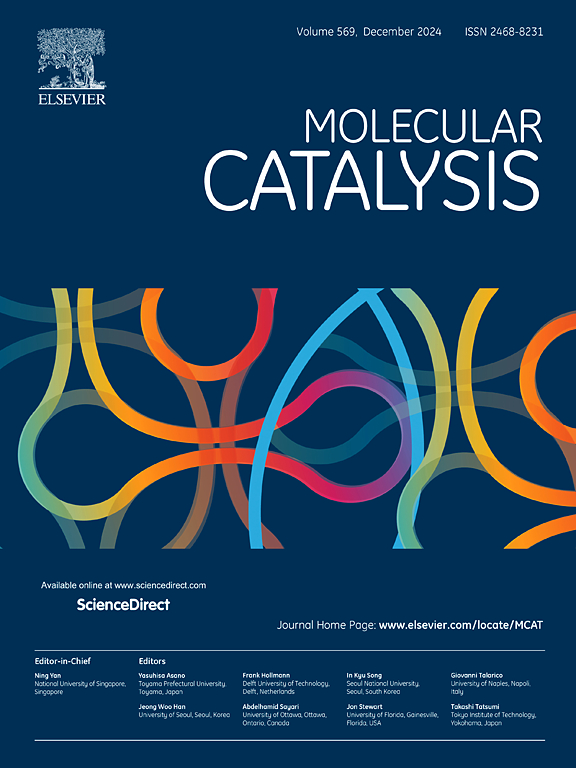Optimizing reverse water gas shift catalysis: Minimizing metal loading and enhancing performance with Pt/ZrO2 catalysts through Rh incorporation
IF 3.9
2区 化学
Q2 CHEMISTRY, PHYSICAL
引用次数: 0
Abstract
In this study, the optimization of catalysts for the reverse water gas shift reaction by minimizing metal loading and enhancing the performance of supported Pt catalysts through Rh incorporation was done. The catalysts were synthesized by the wet impregnation method, in which the metal noble load in bimetallic samples decreased by approximately one-third compared to the reference platinum catalyst, with varying Rh-Pt ratios. In all materials, m-ZrO2, obtained by the hydrothermal method, was used as support. In the catalytic tests in a continuous packed-bed flow reactor at atmospheric pressure, all samples were active to catalyze CO2 reduction between 200 and 300 °C. Bimetallic samples, particularly those with an Rh-Pt atomic ratio of 20–80, exhibited superior performance in the RWGS reaction despite their lower metal content. Based on the results of H2-TPR, FTIR in situ, and XPS, we propose that the enhanced CO production in bimetallic samples compared to Pt/ZrO2 catalysts can be attributed to Rh increasing the reduction extent of supported Pt. This enhancement facilitates the hydrogenation of bicarbonate species into formate species, which subsequently evolve into Pt0-CO and ultimately into CO. Additionally, Rh incorporation enables an alternative pathway for CO generation, where Pt0-carbonyls, known for their CO-producing capability, are formed via CO2 dissociation on the Pt0 surface. However, higher Rh concentrations favor the CO2 methanation rather than the RWGS reaction.

优化反向水煤气变换催化:通过掺入 Rh 使 Pt/ZrO2 催化剂的金属负载最小化并提高性能
本研究通过最大限度地减少金属负载和通过掺入 Rh 提高支撑铂催化剂的性能,对逆向水气变换反应催化剂进行了优化。催化剂采用湿法浸渍法合成,与参考铂催化剂相比,双金属样品中的金属惰性负载减少了约三分之一,Rh-Pt 的比例各不相同。在所有材料中,均使用通过水热法获得的 m-ZrO2 作为载体。在常压下的连续填料床流动反应器中进行的催化测试中,所有样品都能在 200 至 300 °C 之间有效催化二氧化碳还原。双金属样品,尤其是 Rh-Pt 原子比为 20-80 的样品,尽管金属含量较低,但在 RWGS 反应中表现出更优越的性能。根据 H2-TPR、原位傅立叶变换红外光谱和 XPS 的结果,我们认为,与 Pt/ZrO2 催化剂相比,双金属样品中 CO 生成量的提高可归因于 Rh 增加了支撑 Pt 的还原程度。这种增强促进了碳酸氢盐物种氢化为甲酸盐物种,随后演化为 Pt0-CO,并最终转化为 CO。此外,Rh 的加入还为 CO 的生成提供了另一种途径,即通过 Pt0 表面的 CO 离解形成 Pt0-羰基,而 Pt0-羰基具有产生 CO 的能力。然而,较高的 Rh 浓度有利于 CO2 甲烷化反应,而不是 RWGS 反应。
本文章由计算机程序翻译,如有差异,请以英文原文为准。
求助全文
约1分钟内获得全文
求助全文
来源期刊

Molecular Catalysis
Chemical Engineering-Process Chemistry and Technology
CiteScore
6.90
自引率
10.90%
发文量
700
审稿时长
40 days
期刊介绍:
Molecular Catalysis publishes full papers that are original, rigorous, and scholarly contributions examining the molecular and atomic aspects of catalytic activation and reaction mechanisms. The fields covered are:
Heterogeneous catalysis including immobilized molecular catalysts
Homogeneous catalysis including organocatalysis, organometallic catalysis and biocatalysis
Photo- and electrochemistry
Theoretical aspects of catalysis analyzed by computational methods
 求助内容:
求助内容: 应助结果提醒方式:
应助结果提醒方式:


